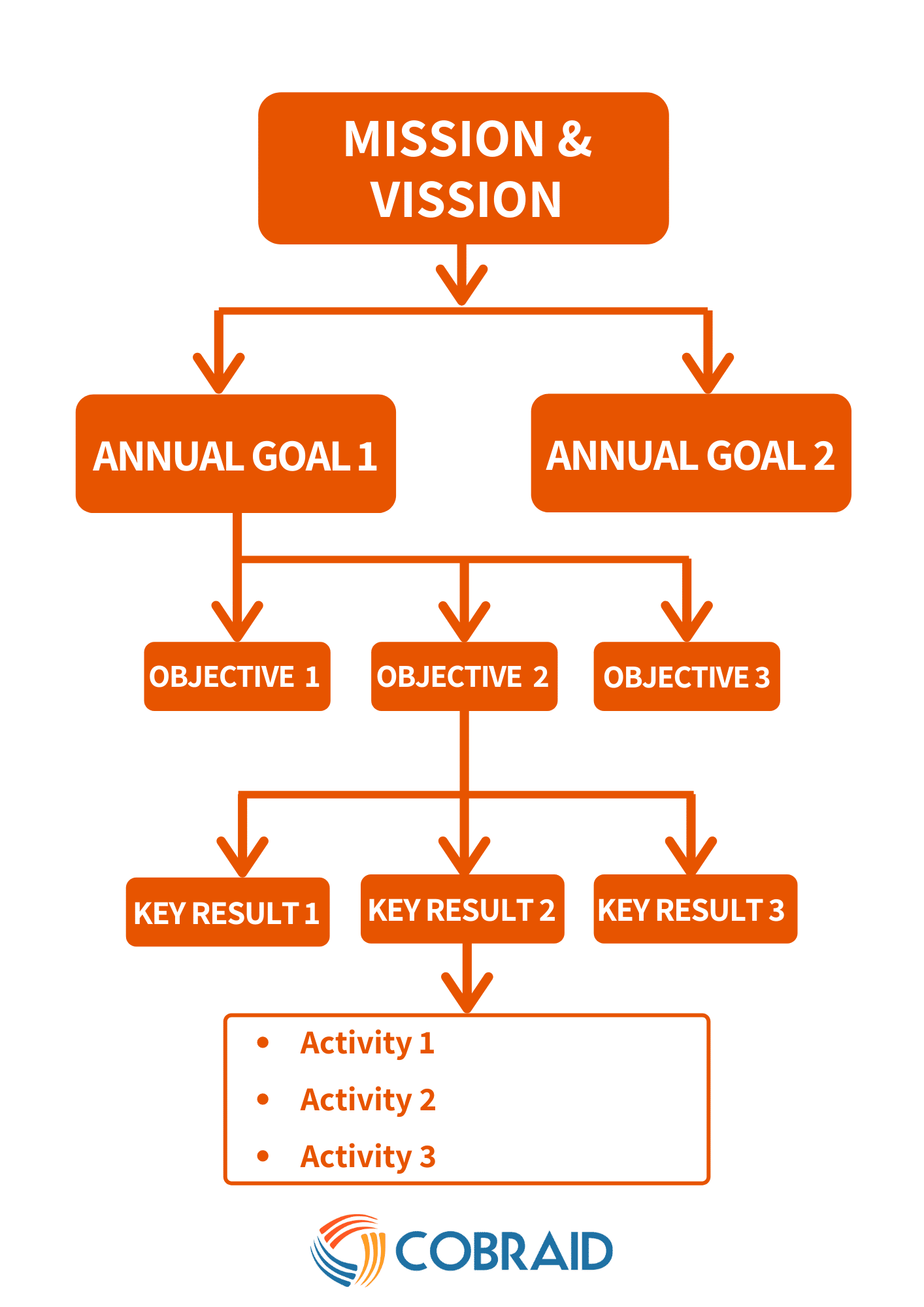You made a killer vision and a really good sounding mission but what do you do from here? How do you actually create a strategy that will not just end up in the drawer? I’ll introduce you to how to plan strategic objectives with one of four frameworks – stay tuned.
What is strategic planning?
You might know things like Porter’s Five Forces, SWOT analysis or vision statements. Those help you define the business strategy.
The thing many managers struggle with is making it operational and meaningful. Because how do you make it relevant to all employees in their everyday work life?
Things tend to get hard when you have to convert all the fancy words and good intentions into a plan that is actually working. The real struggle begins when you have to turn “Our vision is to create a better everyday life for the many people.” into something you can do. How do you make it operational for the service worker in the warehouse or the marketeer at the office?
To do this is what some are calling strategic planning. We want to take a fluffy statement and translate it to business objectives. This means translating it into goals like “An increase of returning customers by 30% in 2025”. From there we then want the entire company to work towards that, but how do you do it? How do you plan your strategic objectives?
It seems that there is not a single answer to this question. At least not one I can give you, but there might be a true answer for you. It all depends on your business, the type of company, the culture, the strategy and much more. Let’s compare four different frameworks that guide you through the strategic planning process. They will all address the journey from dreaming to doing.
Frameworks for working with strategic planning
The four different frameworks that I will compare are called
- OKR
- Hoshin Kanri
- Must-win battles
- Balanced Scorecards
They are different in how they work and some might even argue that they are not comparable. I’ll give you my best attempt regardless of that.
We will go through the general idea behind them and how they define objectives, KPIs, goals and so on. The goal is to give you an idea of how you can plan strategic objectives in your own organization.
OKR
The returning reader might notice that OKR is no stranger to this blog. We have talked about it multiple times since we find it interesting and a good way of working with SMART goals.
OKR stands for Objectives and Key Results. To plan strategic objectives is a core feature of this framework as the abbreviation implies. It has its own process of breaking down the strategy into manageable and executable chunks. This process can be illustrated as in the figure below.

Note that the OKR framework does not allow to subdivide objectives into smaller chunks infinitely. Instead, things are broken into yearly objectives, quarterly objectives, key results, and to-dos. The idea is that there are no goals running for more than a year even though the vision might carry on for many years. This is especially useful for companies working in industries that develop rapidly like the IT industry. I’ll get back to that later when we take a look at how to choose a framework when you want to plan strategic objectives.
Hoshin Kanri
Hoshin Kanri is a framework mostly used by production companies. It has its roots in the lean framework but that does not mean that it has no use elsewhere.
The framework originates in Japan and translates to Compass Management. That sounds like a way to plan strategic objectives right?
Hoshin Kanri is a well known framework and is even the ancestor of OKR sharing a lot of ideas. It starts with a top-down approach to strategy implementation. That is also true for OKR but it is much more distinct in this framework.
The framework allows you to split objectives into smaller bits infinitely. A feature that can be either well used or abused so be careful with how you break things down.
Let’s briefly touch terminology in Hoshin Kanri as we’ll go into more detail later.
It all starts with the “True North” or what is known as the vision by most people. The vision is then divided into 3-5 year breakthrough objectives. Those are then divided into annual goals and improvement priorities. Lastly, we define initiatives and then the bowling chart KPIs.
If you look up Hoshin Kanri you’ll most definitely find the x-matrix. This is where the objectives connect and split into goals and initiatives. The x-matrix an easy but yet effective tool that is well spread amongst production companies. The image below shows an example of how to use the x-matrix and what it looks like.

https://www.clearpointstrategy.com/hoshin-kanri-matrix-template/
Note how the improvement priorities break into sub-objectives. This gives Hoshin Kanri its infinite levels of goals.
Must-win battles
Must-win battles are very different from the two other frameworks we have looked at so far. It is pretty new in terms of strategy frameworks as it was introduced in 2005 by Peter Killing and Thomas Malnight.
You might have heard the term “burning platform”. This is what the Must-win battles use as fuel for the strategy. Instead of setting goals for the business we define a set of so-called Must-wins. Those are tasks that we cannot postpone or not do. They simply need to be done, and that is creating the burning platform.
Implement Consulting Group define must wins as shown in the box below. Note that the “how will it look like when it is accomplished within 6 to 9 months” is very close to what other frameworks define as a goal. It has parts of the SMART acronym built into it. It is a very easy and down to earth way to plan strategic objectives
One thing to notice here is how easy and understandable this framework is. Some might think it is a bit too lightweight to work on its own and it is therefore also used by middle management. They use it as a way of keeping a strategic focus in the day-to-day work. One of the main aspects is that it’s forcing the employees to work on these very specific tasks. The Must-win battles can be used in conjunction with larger frameworks like the balanced scorecards.
Balanced scorecards
And now we will go from the new boy in class to one of strategic planning’s grand old men. The balanced scorecards are widely adapted across the globe, and especially in larger companies. The reason for this is, that it might be a bit over the top for smaller businesses.
It might be overwhelming as it requires the company to be able to plan years ahead. This approach works for some, but is also one of the reasons that other frameworks have evolved. Critics may state that it is rigid and only works in an ideal world. The lack of agility makes it hard to change the strategy. This might be a problem as it is often hard to plan strategic objectives more than just a year or two in advance.
The balanced scorecard isolates four different areas. Those are then addressed in the strategy. This approach is very different from the other frameworks.
The areas are:
- Learning and growth
- Business processes/internal processes
- Customers
- Finance
The idea of not only focusing on finance was groundbreaking when it was first introduced in 1992. At that time strategy was all about the financial parts of the business.
“The balanced scorecard is used to attain objectives, measurements, initiatives, and goals that result from these four primary functions of a business” as investopedia writes.
To do this a so-called strategy map is used. Business objectives are all related to the aforementioned areas. The balanced scorecard is using arrows to show the connection between strategic objectives.
The different objectives are then described as measures and targets. The measures are numbers that are used to define the targets that you want to reach. The image below shows an example of a strategy map used to plan strategic objectives.

Inspired by: Intrafocus.com
KPIs – goals – objectives – what do you mean?
You might have noticed that words like objectives, goals, and KPIs have been used inconsistently throughout this post. The reason for this is that they have different meanings in the different frameworks.
But worry no more I’ll compare many of the words in a moment. Before I do that let’s explain how we use the words here at Cobraid.
Goals
We use the term goal for things that follow the SMART goal acronym. Meaning that they should be specific, measurable, attractive, realistic and time bound. Other variations of the acronym exist but you get the idea. The goal is what you want to achieve and should be expressed as a number. An example could be “we want to increase revenue by 20% in 1 year”. We see this as the keystone and the end result when you plan strategic objectives.
KPI
The term KPI is used as a way of measuring things. We see the KPI as the foundation for a goal, the measurable part to be exact. A KPI is a thing that indicates how we are performing.
Objectives
You won’t find the word objective used a lot on our website. We normally prefer some of the other terms instead as the definition might conflict with goals or KPIs depending on the definition. In general, we see objectives as things you want to achieve. They are not as concrete as goals or KPIs but describe what is important. “Higher revenue” could be an objective. As we see it.
Actions
Actions are the things you and your team do to try to reach a goal. It is a structured task with a clear definition of done.
Vision
The vision is the place of dreams so to speak. It is a statement that inspires and guides all activities in the company. You might recognize some of the most famous vision statements like the one at the beginning of this post.
The following table is my best attempt to compare the terminology from the four frameworks
| Cobraid | Hoshin Kanri | OKR | Must-win battles | Balanced Scorecards |
| Vision | True North | Vision | N/A | Vision |
| Objectives | 3-5 year breakthrough objectives | N/A | N/A | Objectives |
| Goals | Annual goals | Annual objectives | N/A | Targets |
| Improvement priorities | Quarterly objectives | N/A | ||
| Actions | Initiatives | To-dos | N/A | Initiatives |
| KPIs | Bowling Chart KPIs | Results | N/A | Measurements |
Sources: http://www.balancedscorecardreview.com/pages/bsc-concept/components/initiatives-45.html
https://balancedscorecard.org/bsc-basics-overview/
https://i-nexus.com/blog/hoshin-kanri-ogsm-okr-apples-oranges-comparison/
https://implementconsultinggroup.com/middle-manager-must-win-battle/
As you can see it is hard to map the concepts in the Must-win battles. The Must-wins is a very different concept and is often used in conjunction with other strategy frameworks. One of the pros is that this framework is a very operational way to plan strategic objectives
Choosing a framework for planning strategic objectives
Now with all this explanation aside then how do you decide on a framework when you want to plan strategic objectives? Well, the true answer is, that it is up to you.
You might like the shorter cycles of the OKR framework or the simplicity of the Must-win battles. It could also be that you like the x-matrix of the Hoshin Kanri framework. Maybe you just like the guidelines and rules in a good old Balanced Scorecard.
No matter the case then choose a framework that inspires you and helps you plan you strategic objectives. Using something that makes sense to you makes the implementation much easier.
But one thing is true for all the frameworks. They all have elements of what I will call continuous improvements. To me that shows that it is important to continuously keep track of your current strategy. You have to watch the progress of your goals, objectives, or KPIs – whatever term you like.
It sounds hard to do, but it is paramount to your strategy’s success as it helps you to stay focused.
If you find this overwhelming then I’ll recommend you to take a look at our tool Cobraid Deploy. It simply makes data management and visualization a lot easier. If you would like to know more, then check it here.
And finally, If you like content like this then be sure to check out the other blog posts we made. Also, be sure to sign up for the newsletter for more content.
Now choose a framework and plan strategic objectives that inspires you. May you reach all your goals.



